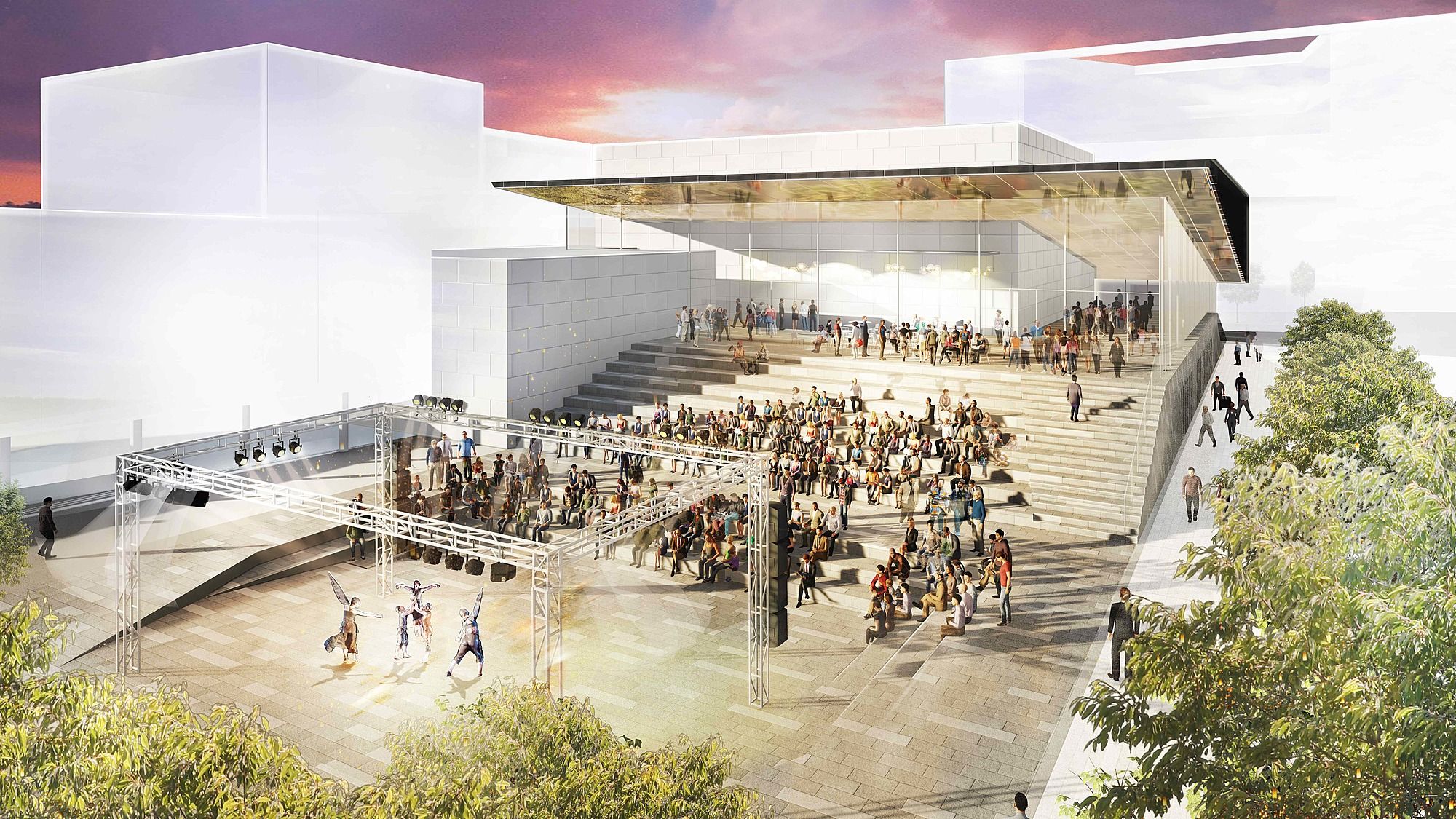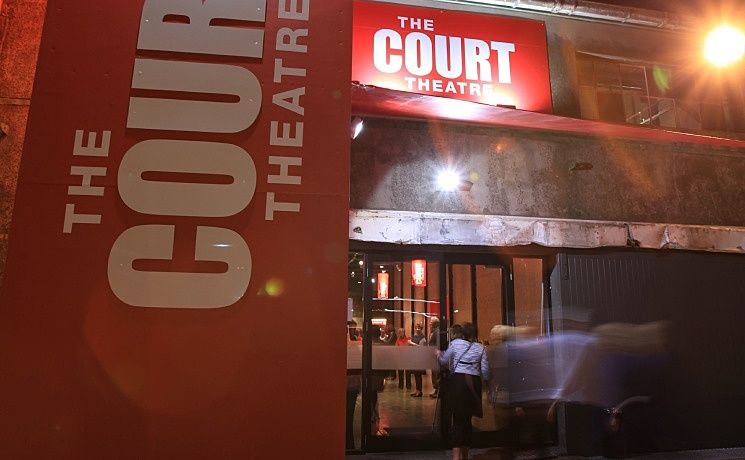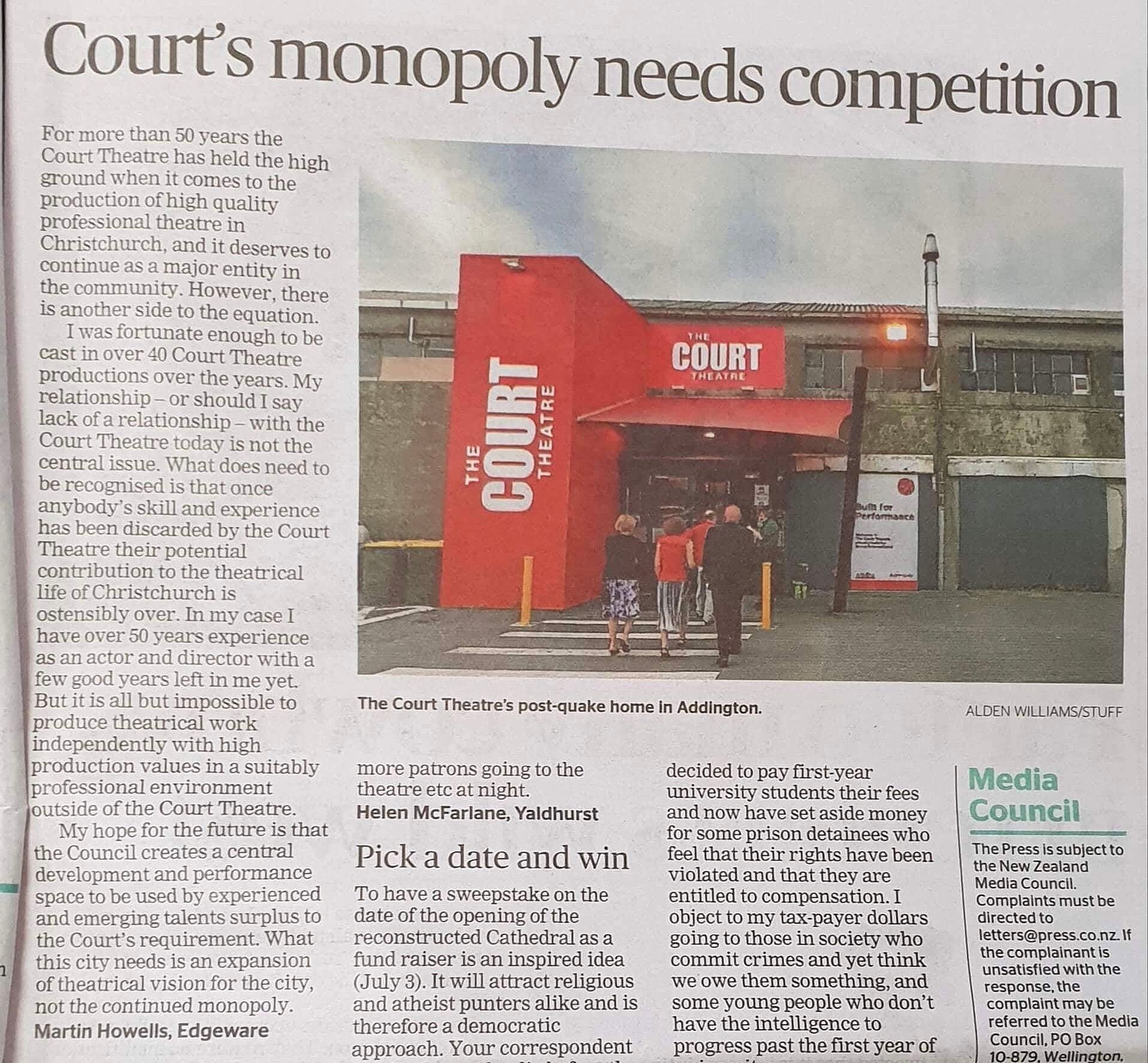Back to the Future: Spaceships, Tōtara, and the Christchurch Performing Arts Precinct
Triumph or monopoly? Erin Harrington on Christchurch City Council's recent decision for the performing arts precinct.
Erin Harrington reflects on Christchurch City Council's decision to prioritise plans for the Court Theatre in the city's performing arts precinct, taking the proposal for the multi-use Andromeda complex out of orbit.
The Christchurch rebuild creaks along, but this week the Christchurch City Council made a decision on the future of the newly-minted performing arts precinct that will have significant repercussions for the arts in New Zealand. The Council’s choice to move ahead with proposed plans for a new home for the Court Theatre alone, rejecting the alternative proposal for the Andromeda arts complex, has been met with shouts of celebration, frustration-laden expletives, and a swift and vocal backlash from some members of the performing arts community.
The two major proposals for the precinct have been unhelpfully framed by media as a vicious cage match. In one corner, hometown heroes the Court Theatre, with their $45 million plan to build a mainstage, a multipurpose space, and a car park (which would be built first to bring in revenue). In the other, scrappy challenger Michael Bell and his $19 million sci-fi themed theatre and entertainment complex Andromeda (the initial concept drawings of which were likened to a spaceship or dubbed 'the purple croissant'). Each has been asking for a slice of the $30 million allocated to the new performing arts precinct, a small block of land bounded by Armagh, Gloucester, Colombo and New Regent Streets, which already houses the Isaac Theatre Royal and The Piano Music Centre. The seemingly huge pot of $30 million at the centre of the process is what is officially known as ‘chump change’ in the grand scheme of rebuild costs; for comparison, the covered stadium is currently budgeted at $496 million, and that’s a venue that will sit empty most of the time. It’s not even enough to cover the costs of the Court Theatre’s proposal; they’ll have to fund the rest themselves.
Even if you don’t know Christchurch well, you will likely know of the Court Theatre. Funded by Creative New Zealand under the Toi Tōtara Haemata investment programme, the country’s largest theatre company has 60 permanent staff, two stages, a long-running improv company, and a vibrant education and development programme. After their home in the Christchurch Arts Centre was rendered dangerous and uninhabitable in the February 2011 earthquakes – the site is still fenced off – they undertook what can only be described as extreme fundraising, and reopened in a converted grain shed in the suburb of Addington just eight months later. It was an extraordinary, utterly inspiring feat. Their presumed presence in the performing arts precinct was alluded to all the way back in 2012 in the Christchurch Central Recovery Plan, which carved the central city into tidy little coloured rectangles where like meets like.
In his Andromeda proposal, developed over three and a half years, arts entrepreneur Michael Bell presented a theatre and entertainment complex that aimed to house multiple flexible venues alongside affordable tenancies and co-working spaces, that could potentially serve and support independent companies in Christchurch, as well as touring productions. The final proposal, in which the building was redesigned from the 'purple croissant' to a luminous white cube (pictured in the feature image above), included a range of venues: a 400-seat flexible theatre, a 150-seat fringe theatre, and an 80-seat rooftop jazz and comedy bar, as well as a foyer and an outdoor piazza that could also host peformances. On top of this, it proposed an tech-heavy, whizzbangy, high-end sci-fi-themed in-house cabaret production aimed at the tourist market. It was designed with the precinct’s location and $30 million budget in mind, and it intended to support the arts locally (taking advantage of Christchurch’s strengths in jazz and musical theatre) while attending to the visitor economy, the need for job creation, and the potential to nurture connections between Christchurch’s creative and technology sectors. A key aspect of the proposal was fostering the sense of round-the-clock urban buzz that Christchurch lacks – where people could drop in on a whim, and wouldn’t just bugger off home for a cup of tea after seeing a show.
After a protracted submission process, Tuesday’s decision from the Council was to invite the Court Theatre alone to develop a full business case and concept design with a new Council-run Theatre Working Group, rather than allowing both parties to develop business cases before committing. It’s a deeply frustrating decision. This has absolutely nothing to do with the Court themselves; they need proper premises, they are a much-loved cornerstone of the performing arts in New Zealand, and it will be amazing to have them back in town. But the decision represents a lost opportunity, and raises questions about the nature of the Council’s decision-making process. Because alongside the ongoing choices to jam things into little coloured precinct boxes, tagged with ring-fenced amounts of cash, this choice does not take into account what Christchurch needs to develop a productive, diverse arts ecology. Nor does it recognise how that will offer social, economic and cultural benefits to the city.
It doesn’t help that, from the outset, the Court has been framed as the experienced contender to beat. Yet Michael Bell is highly respected in the New Zealand arts community. He’s probably one of the best-connected creatives in the country, and he has a genuine interest in supporting the arts from the grassroots up – as evidenced by his businesses New Zealand Playhouse and Orange Studios – and in creating spaces that facilitate good work through good relationships. The long proposal process itself, though, has forced each camp to actively tear each other down. In a sector that relies on collaboration, it’s created division throughout the arts community, and put individuals into extremely awkward spots.
The proposals might both look like bricks-and-mortar projects, but their intents diverge considerably
The ‘battle for arts precinct supremacy’ is a tidy media narrative, but it ignores complexity. What’s been sorely missing from public discussions about the performing arts precinct is that the Andromeda proposal was designed to attend to some long-standing, significant deficits in Christchurch’s artistic ecosystem, and it offered some solutions and desperately needed leadership. The proposals might both look like bricks-and-mortar projects, but their intents diverge considerably.
The Andromeda proposal acknowledged that Christchurch lacks sufficient physical arts infrastructure. We are an urban centre that services between 400,000 and half a million people, depending whether you count satellite areas, but we have a dearth of functional, professional performance spaces. Too many of our creatives struggle away in non-traditional, overbooked spaces such as drafty community halls, bars and school auditoria, and without the benefit of logistical, administrative or even basic technical support.
Those who are not directly involved in the arts may not realise that Christchurch audiences regularly miss out on touring national and international shows, both large and small, because we just can’t accommodate them. Even within arts festivals, performances often end up in less-than-ideal temporary or multi-use venues. If we can’t welcome and host our peers, colleagues and idols, we can’t nurture those relationships, and our regional arts environment is impoverished.
This problem with a lack of dedicated professional venues and a preponderance of scattered creative silos existed prior to the earthquake. It was the subject of official arts hui and unending teeth-gnashing pub conversations. In a city marked by suburban sprawl and competing interests it was the great unfixable problem – too big for one organisation, and too important to ignore.
But Andromeda did something that I don’t think anyone was expecting: it pitched a feasible, sustainable and profitable way to bring together diverse groups in a manner that fostered physical, technical and interpersonal support
But Andromeda did something that I don’t think anyone was expecting: it pitched a feasible, sustainable and profitable way to bring together diverse groups in a manner that fostered physical, technical and interpersonal support. It said to local companies and artists: you are valued. Let’s build a community. Let’s share some of the risk. How can we help? These are not problems that a single company like the Court can truly address, nor should they. They are the biggest show in town, and they have their own goals and priorities.
The Andromeda proposal recognised that a lack of sufficient infrastructure has stunted the development of our artistic communities. Christchurch has a large and active performing arts community, as befits a city of its size. It ranges from theatre training grounds like the National Academy of Singing and Dramatic Art (NASDA), to pro-am companies like Showbiz Christchurch, which stages million- dollar musicals, to experimental companies such as the 39-year-old Free Theatre and innovative companies like Two Productions, who act as mentors to emerging artists. There are professional touring companies like Rollicking Entertainment, successful community co-ops like Top Dog Theatre and the NO Theatre Collective. And there are more theatre, cabaret, alternative performance and comedy groups than I can keep track of – all of whom Andromeda was similarly geared towards.
You wouldn’t know that all of this is here if you didn’t know where to look, because there’s never been the sense of critical mass that’s engendered and supported by good social and physical infrastructure. If you have a narrow view of what the performing arts look like – traditional scripts, proscenium arch, pinot gris at half time, chin-chin – you might not realise it’s here at all.
But unfortunately too many of these companies scramble for scant resources. We are suffering from a creative brain drain: too many of our established practitioners know that they cannot sustain a career here, even those who have had long and productive relationships with the Court. Too many young artists see their futures elsewhere. If we don’t tend to our people, we don’t have a community.
What the Andromeda proposal offered, then, was some practical steps in the right direction: space, visibility, interdisciplinarity, community, cross-pollination and support. A low-stakes environment for high-stakes creative experimentation. These companies could gather a sense of momentum that would challenge the widely held, but incorrect stereotype that theatre in Christchurch only looks like middle-of-the-road comedies aimed at Boomers.
Christchurch audiences deserve to see varied local work, featuring a combination of emerging and established artists, alongside outstanding touring theatre from around the country and the world, and Christchurch creatives deserve welcoming, equitable infrastructure that celebrates plurality and champions excellence. The Court Theatre deserves not to have the weight of an entire city’s theatrical tastes and ambitions placed upon their shoulders. A single successful company – a single large employer – cannot fulfil all of Christchurch’s artistic needs, and nor should they be expected to.
As arts reporter Charlie Gates asked in an opinion piece for The Press in April, why can’t we have both the Andromeda and the Court, so that the city can have the performing arts precinct it deserves? For my money, I would have liked to have seen both projects exist side by side in some form – emphasising the Court’s role as creative leader (or apex predator, depending on your perspective), but acknowledging that to have a healthy ecosystem we need across-the-board collaborative relationships and equitable access to resources. It’s notable that the Andromeda proposal (and Michael Bell's impassioned but gracious response to the decision) assumed that the Court would be their neighbour in some form; the Court’s proposal was all or nothing. One organism can’t take all the sunlight. In the arts, diversity is strength.
It’s notable that the Andromeda proposal assumed that the Court would be their neighbour in some form; the Court’s proposal was all or nothing
What really chafes is that this decision is entirely symptomatic of post-quake Christchurch. It symbolises a short-sighted embrace of the familiar, and it stinks of that conservative tendency to be suspicious of the new or the innovative. Throughout the rebuild, bright and bold ideas across multiple disciplines have been held up as an example of the city’s creativity, ingenuity and – wait for it – resilience. We’ve been asked how we want to tell the world who we are, over and over again, but we’ve had too many of those ambitions watered down into anaemic SimCity plans, ‘onsite activations’ and aspirational footnotes. There are some genuinely wonderful things occurring across business, hospitality, urban planning, education, industry and the creative arts, but when it comes time to making decisions, bureaucrats at local and national levels have more often than not got cold feet. They’ve downscaled. They’ve rationalised. In defiance of every bit of advice that keeps coming our way, they’ve gone with a plan that looks a lot like the ‘old’ Christchurch, but with some nicer architecture. It might seem safe and comforting, but it’s a failure of imagination. It’s myopic. It’s a shame.
I’m really happy that the Court Theatre will have a new, central home. They deserve it, and so do audiences. But I'm gutted that Andromeda will be heading out into space instead of landing in the developing CBD. We can at least hope that some of those who are in a position to make decisions now or in the future will have realised that when considering our future you can also look up to the stars, and not just look back at the way things were.




